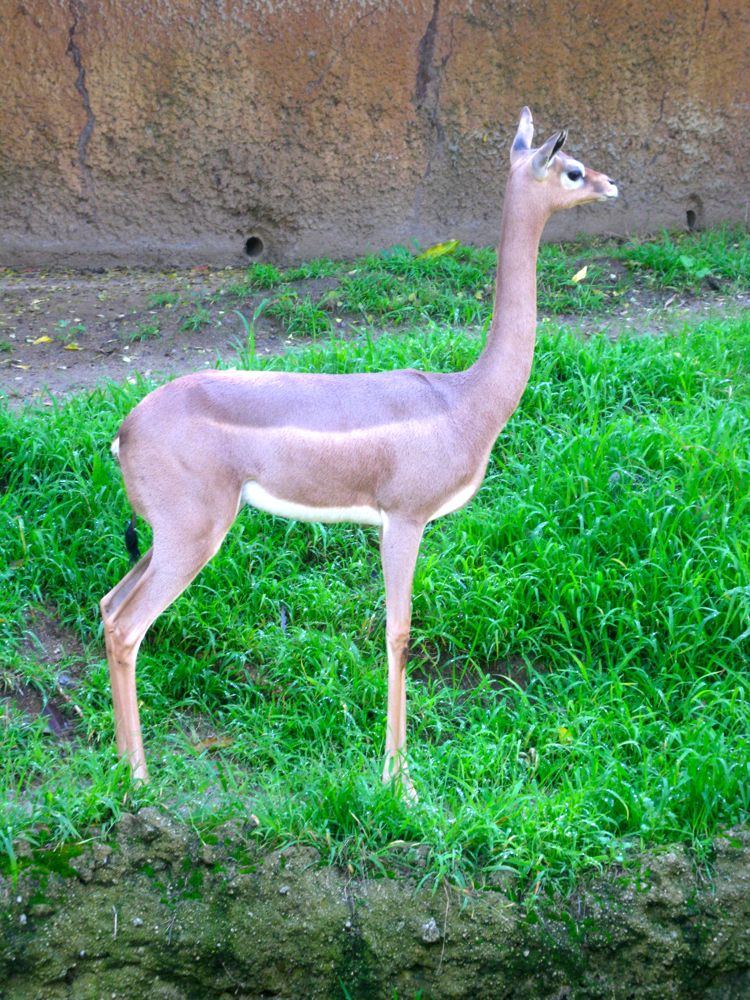The Los Angeles ZooPage One (12/14/2010)
We wanted to go see the new elephant habitat aand as members of the Zoo society we got a special preview invitation. It's about 24 miles from home to the Zoo and by leaving at 9:30 we avoided all the normal traffic!


Its decorated for Christmas
Did you know? - The zoo, located in Los Angeles' Griffith Park, is home to 1,100 animals from around the world. The first zoo opened in 1912 and was about two miles (3.2 km) north of its current site until about 1965. Remnants of the zoo remain and were used in the film Anchorman: The Legend of Ron Burgundy. The site of the current zoo was formerly the location of Rodger Young Village, which was itself built on the land which had been used for the Griffith Park Aerodrome.
Mercats Are A Must Visit
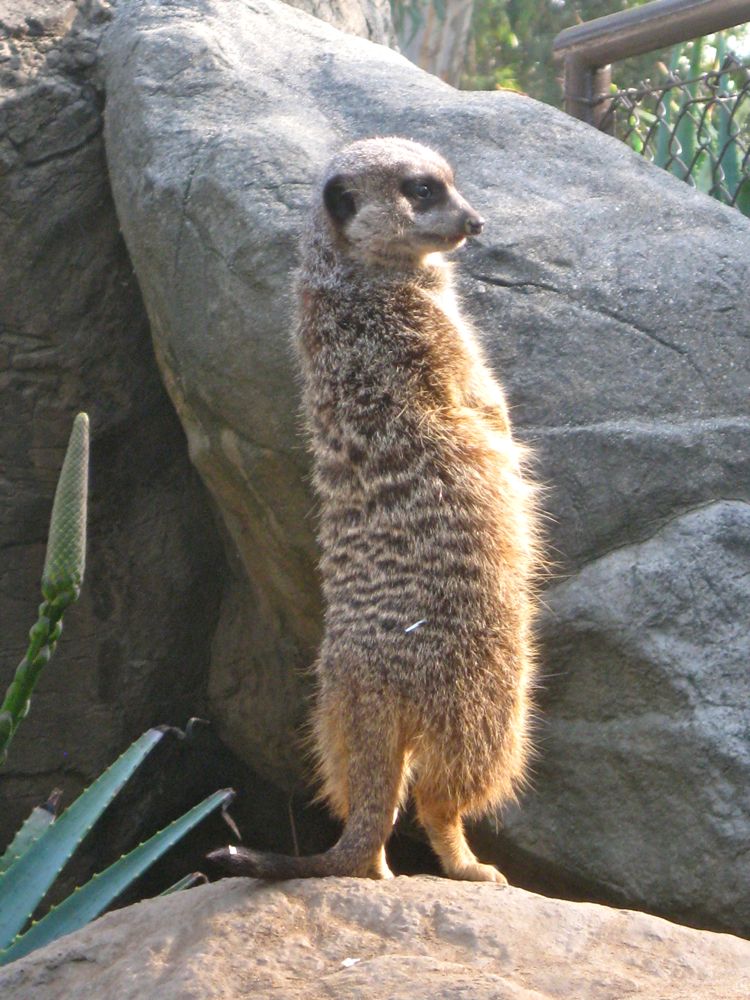
They stand up and say hello
Did you know? - The meerkat or suricate Suricata suricatta, a small mammal, is a member of the mongoose family. Meerkats live in all parts of the Kalahari Desert in Botswana and in South Africa. A group of meerkats is called a "mob", "gang" or "clan". A meerkat clan often contains about 20 meerkats, but some super-families have 50 or more members. Meerkats have an average life span of 12–14 years.

Their expressions are adorable
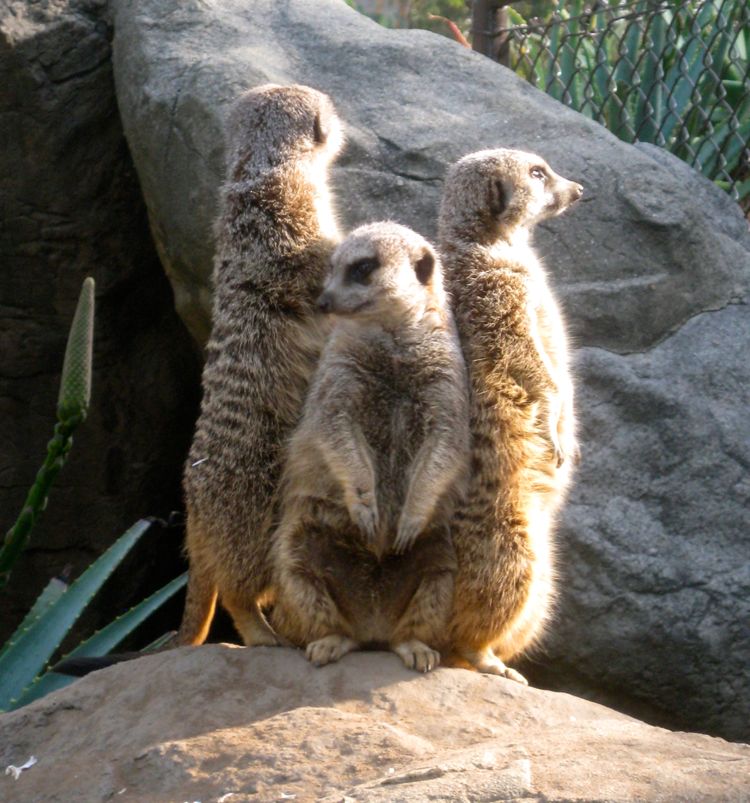
Did you know? - "Meerkat" is a loanword from Afrikaans. The name has a Dutch origin but by misidentification. Dutch meerkat refers to the "guenon", a monkey of the Cercopithecus genus. The word "meerkat" is Dutch for "lake cat", but the suricata is not in the cat family, and neither suricatas nor guenons are attracted to lakes; the word possibly started as a Dutch adaptation of a derivative of a Sanskrit word that meant "monkey", perhaps in Africa via an Indian sailor on board a Dutch East India Company ship. The traders of the Dutch East India Company were likely familiar with monkeys, but the Dutch settlers attached the name to the wrong animal at the Cape. The suricata is called stokstaartje = "little stick-tail" in Dutch.

Hello guys

Did you know? - Meerkats are primarily insectivores, but also eat lizards, snakes, scorpions, spiders, plants, eggs, small mammals, millipedes, centipedes and, more rarely, small birds. They are partially immune to certain venoms; they are immune to the very strong venom of the scorpions of the Kalahari Desert, unlike humans. They have no excess body fat stores, so foraging for food is a daily need.
Meerkats forage in a group with one "sentry" on guard watching for predators while the others search for food. Sentry duty is usually approximately an hour long. Baby meerkats do not start foraging for food until they are about 1 month old, and do so by following an older member of the group who acts as the pup's tutor.[3] The meerkat standing guard makes peeping sounds when all is well. If the meerkat spots danger, it barks loudly or whistles.

Cute but not as a pet
Did you know? - Meerkats make very poor pets. They bite, and the bite can become infected. They stink, and will scent-mark their owner and the house (their "territory"). Being a pack animal, they may become hysterical if kept as single pets
The Zoo Is Also A Botanical Garden
Did you know? - In 2002, the zoo became a certified Botanical Gardens and the official name of the institution was changed to the Los Angeles Zoo and Botanical Gardens. Spread throughout zoo grounds, there are 15 different collections, highlighting over 800 different plant species, with a total of over 7,400 individual plants.
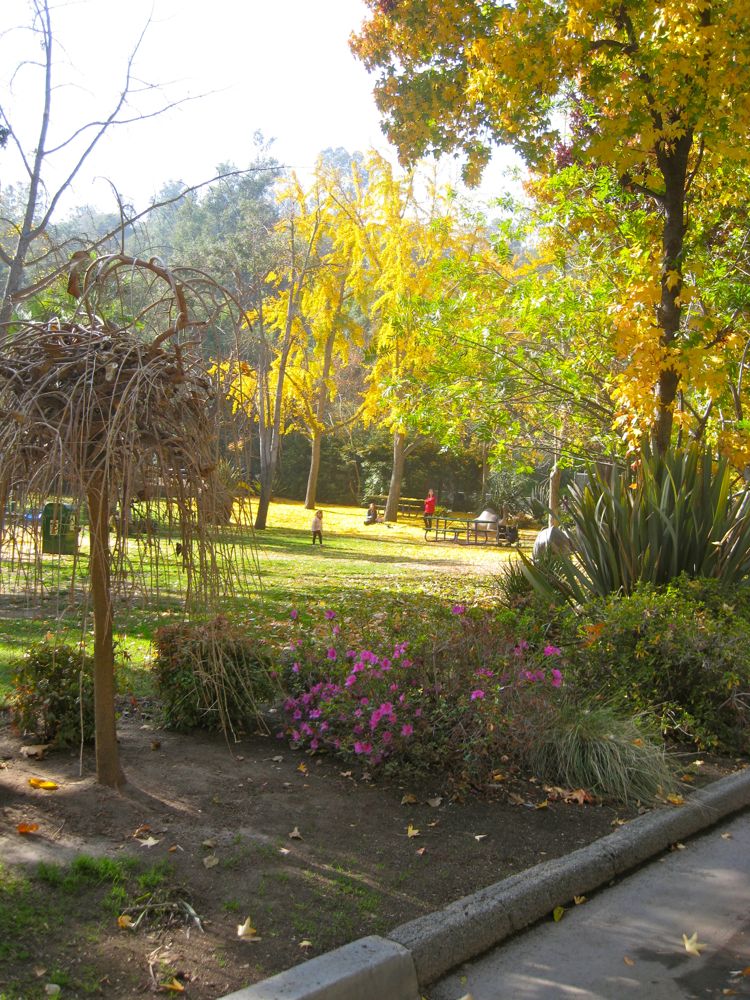
Koalas Are Not Too Bright

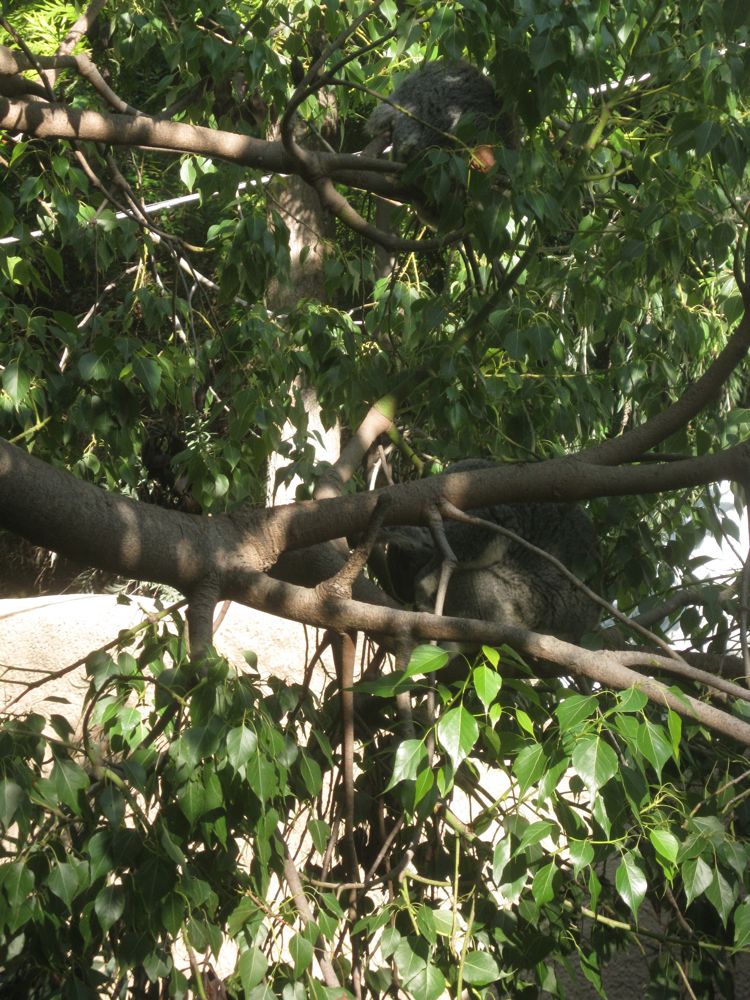
It was warm so they were sleeping
Did you know? - The koala is found in coastal regions of eastern and southern Australia, from Adelaide to the southern part of Cape York Peninsula. Populations also extend for considerable distances inland in regions with enough moisture to support suitable woodlands. The koalas of South Australia were largely exterminated during the early part of the 20th century, but the state has since been repopulated with Victorian stock
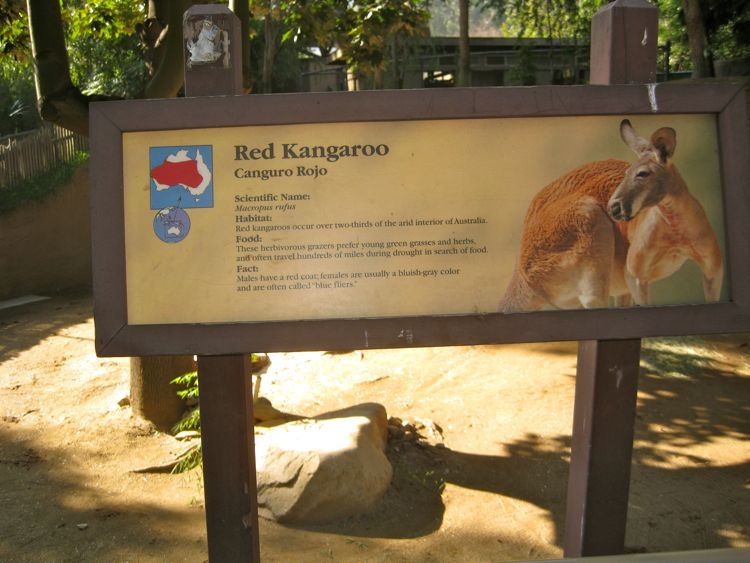
Did you know? - The Red Kangaroo (Macropus rufus) is the largest of all kangaroos, the largest mammal native to Australia, and the largest surviving marsupial. It is found across mainland Australia, avoiding only the more fertile areas in the south, the east coast, and the northern rainforests. The Red Kangaroo's range of vision is approximately 300°, due to the position of its eyes

Lounging around in todays beautiful weaher
Did you know? - The Red Kangaroo's legs work much like a rubber band. The males can leap over 9 metres (30 ft) in one leap. The Red Kangaroo lives alone or in small groups called 'mobs' (although food shortages can cause them to congregate into larger groups).
Each mob is usually made up of 2 to 10 kangaroos, but sometimes a mob can have up to several hundred kangaroos. Membership of these groups is very flexible, and males (boomers) are not territorial, fighting only over females (flyers) that come into heat. The largest males are dominant, and control most of the matings.
When male kangaroos fight, they may appear to be "boxing". They usually stand up on their hind limbs and attempt to push their opponent off balance by jabbing him or locking forearms. If the fight escalates, they will begin to kick each other. Using their tail to support their weight, they deliver kicks with their powerful hind legs.
Wallabys Are Quite Interesting

Did you know? - It is found on offshore islands on the South Australian and Western Australian coast. It persists in large numbers on Kangaroo Island, where it seasonally breeds in large numbers and can become a problem to farmers through competition for pasture and grain crops. High densities of these animals also have impact on the density of low vegetation across the Island.
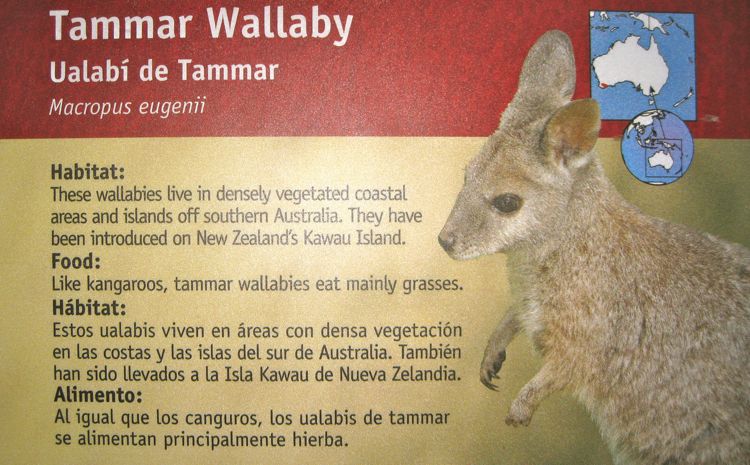
Did you know? - Australian scientists, lead by Dr. Ben Cocks, have found a compound in the milk of the Tammar Wallaby called AGG01 which has the potential to be a new and powerful form of antibiotic. AGG01 is a protein and in laboratory testing AGG01 has been shown to be 100 times more effective than penicillin, killing over 99% of the pathogenic bacteria (both gram-positive and gram–negative) and fungus that it was incubated with, including Salmonella, Proteus vulgaris and golden staphylococcus.
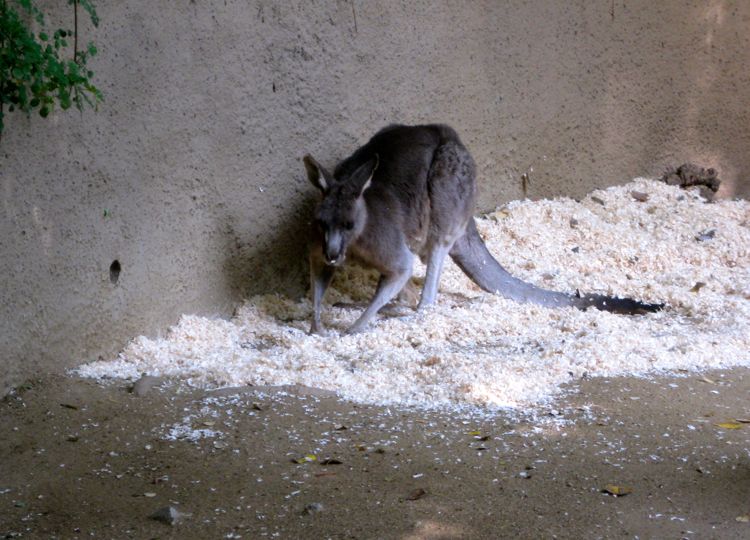
He was watching us!
Not Yet Complete We Go A Preview Only Of The Pachyderm Forest

Indian and African elephants are cared for in the new facility
Did you know? - The newest phase in the evolution of elephant care at the Zoo is Pachyderm Forest, a state-of-the-art elephant habitat currently under construction in the heart of the Zoo. With more than six acres — nearly seven times the size of our current elephant space — this exhibit will be the largest animal habitat in the L.A. Zoo, and one of the largest of any urban zoo in the country. The Zoo’s elephant management program has been hailed as “a model for all to observe" by the Association of Zoos and Aquariums, the organization which accredits zoological institutions nationwide.

The entrance

He has everything
Did you know? - Pachyderm Forest will give our elephants a variety of choices including pools, mudholes, waterfalls, waterholes, varied topography and substrates, and a new state-of-the-art barn to manage and care for these animals.
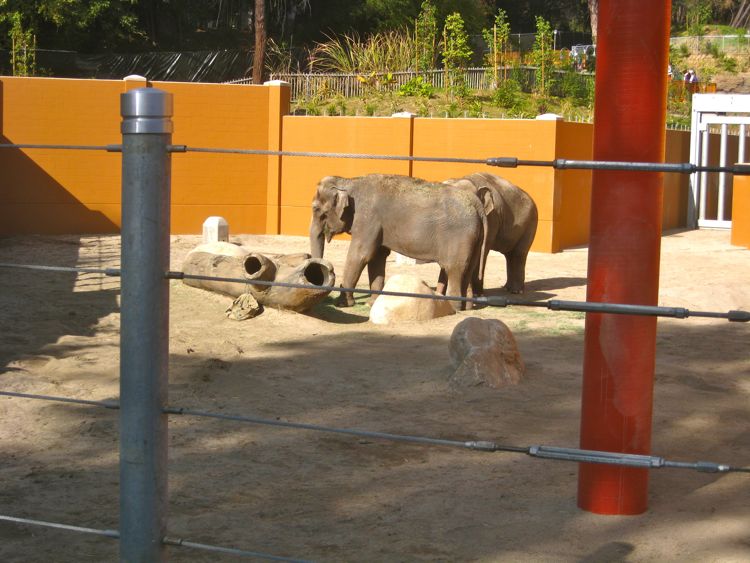
They are dining on hay
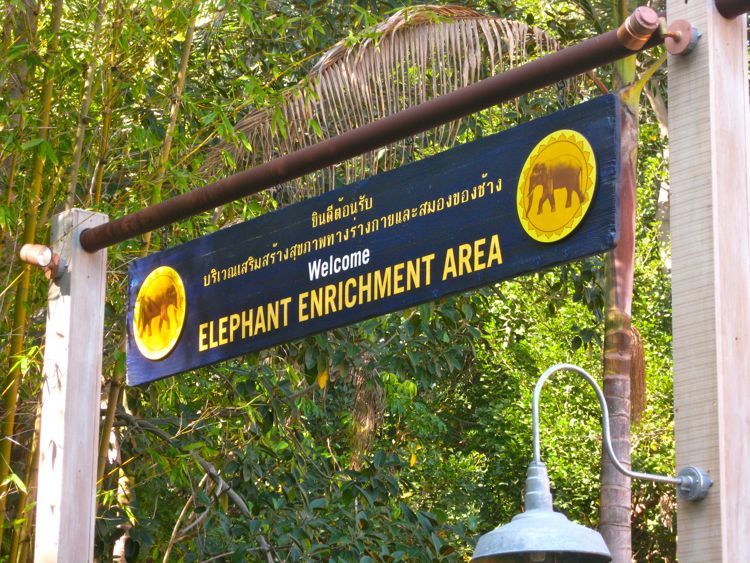
Lots of good information


View into the Indian area



Super waterfall for bathing

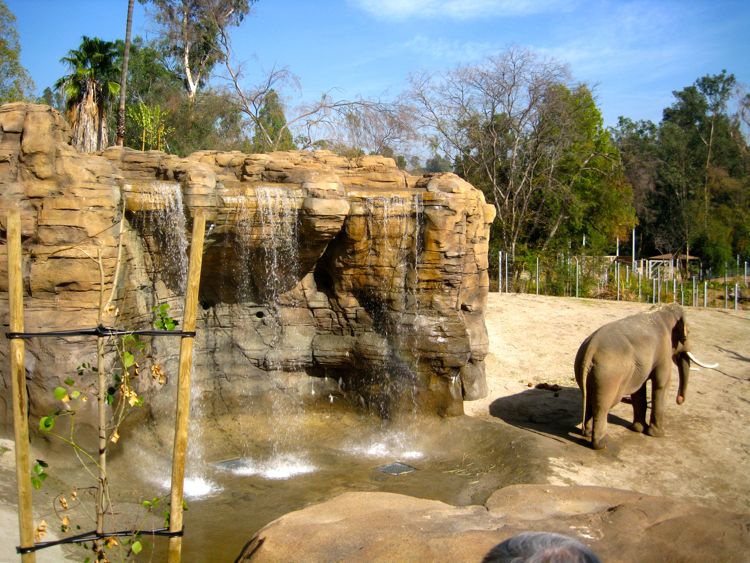

Magnificent animal
Did you know? - The Indian Elephant, Elephas maximus indicus, is one of four subspecies of the Asian Elephant, the largest population of which is found in India. This subspecies is also found in Bangladesh, Bhutan, Cambodia, China, Laos, Peninsular Malaysia, Burma/Myanmar, Nepal, Thailand and Vietnam.
We Must See The Apes
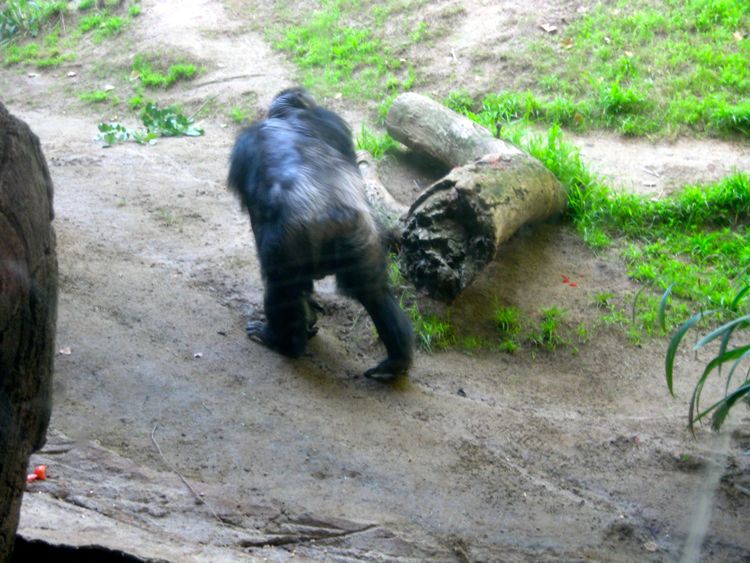
Did you know? - "Ape", from Old English apa, is possibly an onomatopoetic imitation of animal chatter. The term has a history of rather imprecise usage. Its earliest meaning was a tailless (and therefore exceptionally human-like) non-human primate, but as zoological knowledge developed, it became clear that taillessness occurred in a number of different and otherwise unrelated species.
The original usage of "ape" in English might have referred to the baboon, an African monkey. Two tailless species of macaque are commonly named as apes, the Barbary ape of North Africa (introduced into Gibraltar), Macaca sylvanus, and the Sulawesi black ape or Celebes crested macaque, M. nigra.

Funny characters

Time to rest

Who is watching who?

A Visit For Mummy To The Giraffes

"Hi Mummy Redinger"

The entire family is here
Did you know? - The giraffe (Giraffa camelopardalis) is an African even-toed ungulate mammal, the tallest of all land-living animal species, and the largest ruminant. The giraffe's scientific name, which is similar to its antiquated English name of camelopard, refers to its irregular patches of color on a light background, which bear a token resemblance to a leopard's spots.

Here's looking at you
Did you know? - The giraffe has one of the shortest sleep requirements of any mammal, which is between ten minutes and two hours in a 24-hour period, averaging 1.9 hours per day.
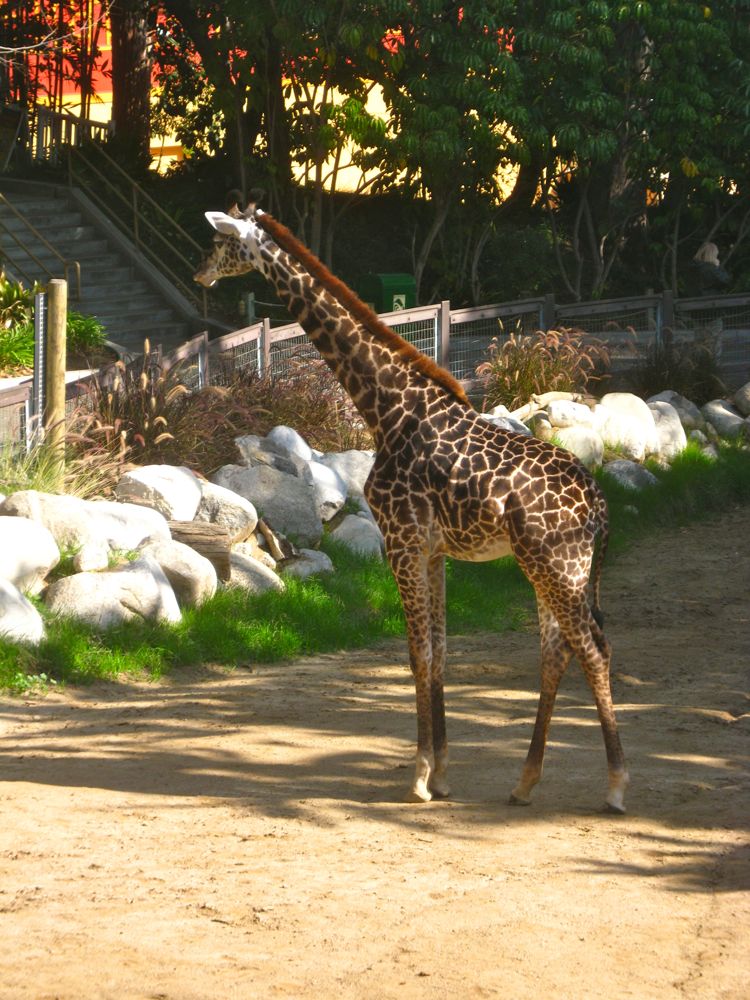
He is called a "Stink Bull"
Did you know? - The giraffe's fur may serve as a chemical defence, and is full of antibiotics and parasite repellents that gives the animal a characteristic scent. Old males are sometimes nicknamed "stink bulls". There are at least eleven main aromatic chemicals in the fur, although indole and 3-methylindole are responsible for most of their smell. Because the males have a stronger odour than the females, it is also suspected that it has a sexual function.
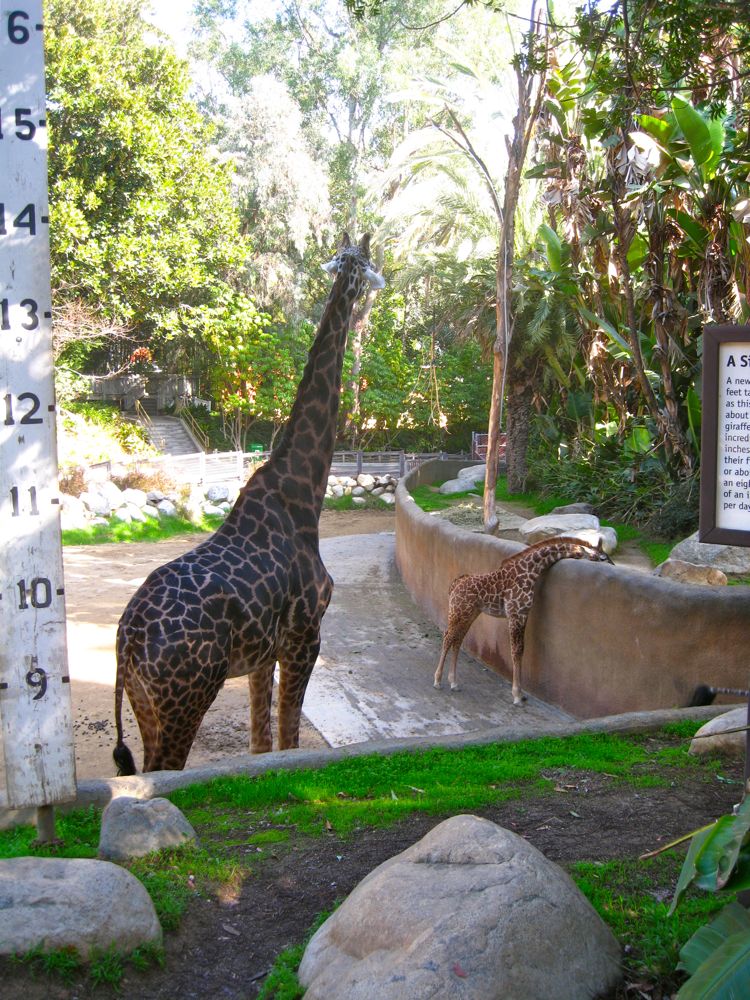
The baby is going to get in trouble
Did you know? - The name giraffe has its earliest known origins in the Arabic word الزرافة ziraafa or zurapha, perhaps from an African name. It appears in English from the 16th century on, often in the Italianate form giraffa. The species name camelopardalis (camelopard) is derived from its early Roman name, where it was described as having characteristics of both a camel and a leopard. The English word camelopard first appeared in the 14th century and survived in common usage well into the 19th century. The Afrikaans language retained it.

"What is over there daddy??"
Did you know? - Male giraffes are up to 5.5 metres (18 ft) tall at the horn tips, and weigh between 800 and 1,930 kilograms (1,800 and 4,300 lb). Females are between 4 and 4.5 metres (13 and 14.8 ft) tall and weigh between 550 and 1,180 kilograms (1,200 and 2,600 lb). The coat is made up of brown blotches or patches separated by lighter hair. Each giraffe has a unique coat pattern. Wild giraffes have a lifespan close to 13 years while those in captivity live up to 25 years.

Did you know? - Giraffes also have slightly elongated forelegs, about 10% longer than their hind legs, and can reach a sprint speed of up to 60 km/h (37 mph). It cannot sustain a lengthy chase. Its leg length compels an unusual gait with the left legs moving together followed by right (similar to pacing) at low speed, and the back legs crossing outside the front at high speed.
When hunting adult giraffes, lions try to knock the lanky animal off its feet and pull it down. Giraffes are difficult and dangerous prey. The giraffe defends itself with a powerful kick. A single well-placed kick from an adult giraffe can shatter a lion's skull or break its spine. Lions are the only predators which pose a serious threat to an adult giraffe.

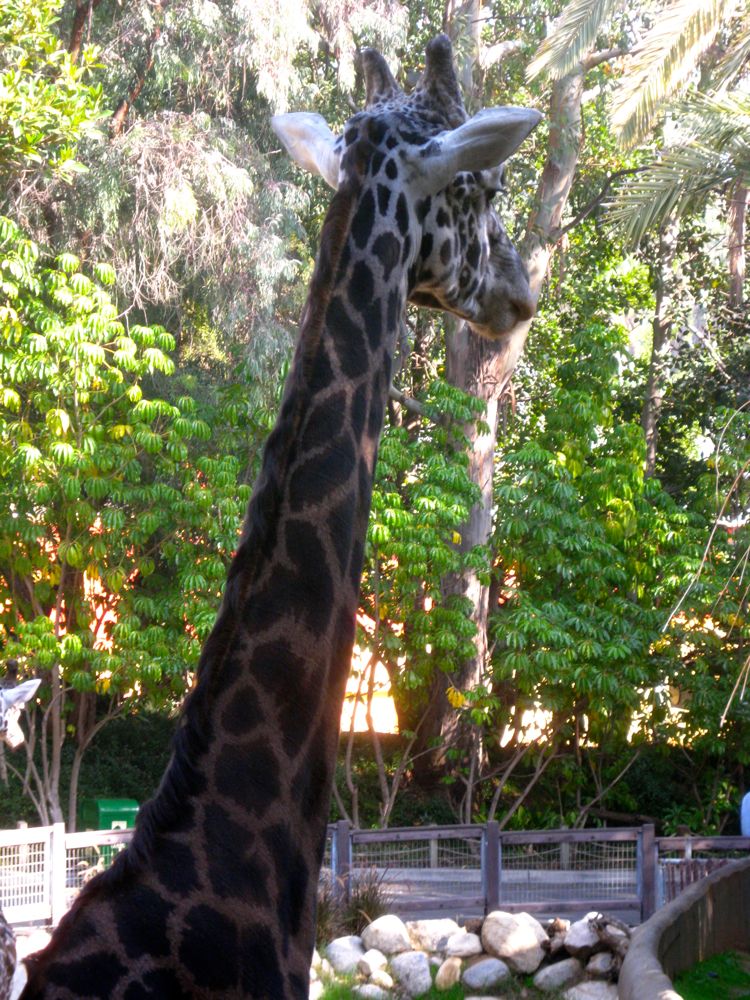
Did you know? - Modifications to the giraffe's structure have evolved, particularly to the circulatory system. A giraffe's heart, which can weigh up to 10 kg (22 lb) and measure about 60 cm (2 ft) long, must generate approximately double the normal blood pressure for an average large mammal to maintain blood flow to the brain. In the upper neck, a complex pressure-regulation system called the rete mirabile prevents excess blood flow to the brain when the giraffe lowers its head to drink.
Conversely, the blood vessels in the lower legs are under great pressure (because of the weight of fluid pressing down on them). In other animals such pressure would force the blood out through the capillary walls; giraffes, however, have a very tight sheath of thick skin over their lower limbs which maintains high extravascular pressure in the same way as a pilot's g-suit.

"OK, I will look there also"
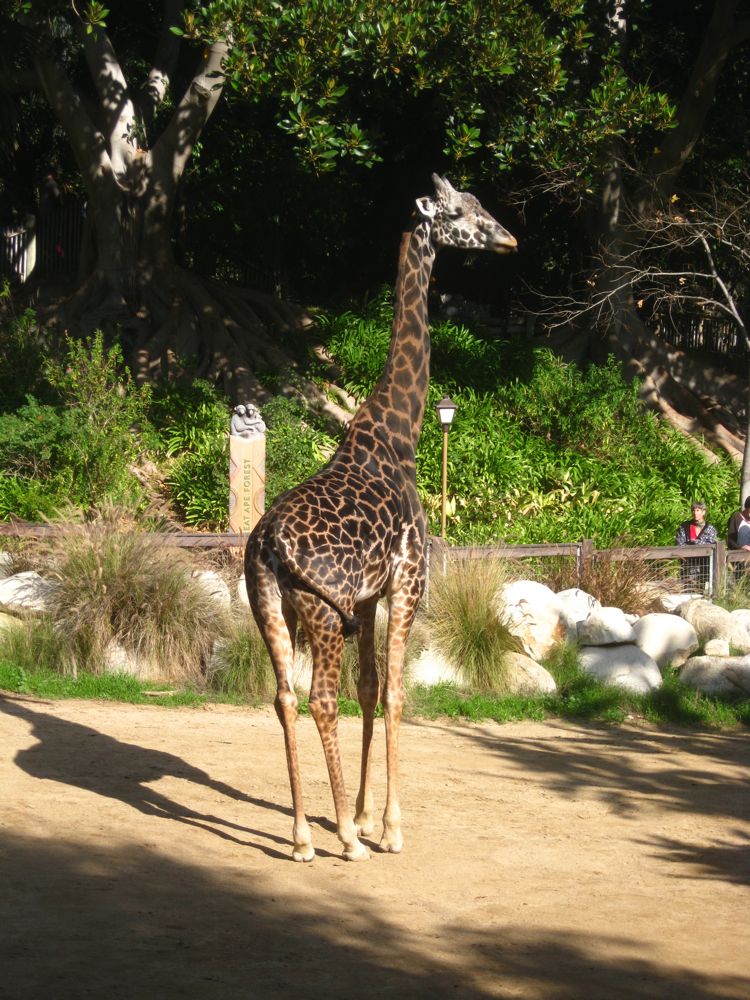
Did you know? - The giraffe browses on the twigs of trees, preferring trees of the genera Acacia, Commiphora and Terminalia, and also eats grass and fruit. The tongue is tough due to the giraffe's diet, which can include tree thorns. In Southern Africa, giraffes feed on all acacias, especially Acacia erioloba, and possess a specially adapted tongue and lips that are tough enough to withstand the vicious thorns of this plant. A giraffe can eat 65 pounds (29 kg) of leaves and twigs daily, but can survive on just 15 pounds (6.8 kg)
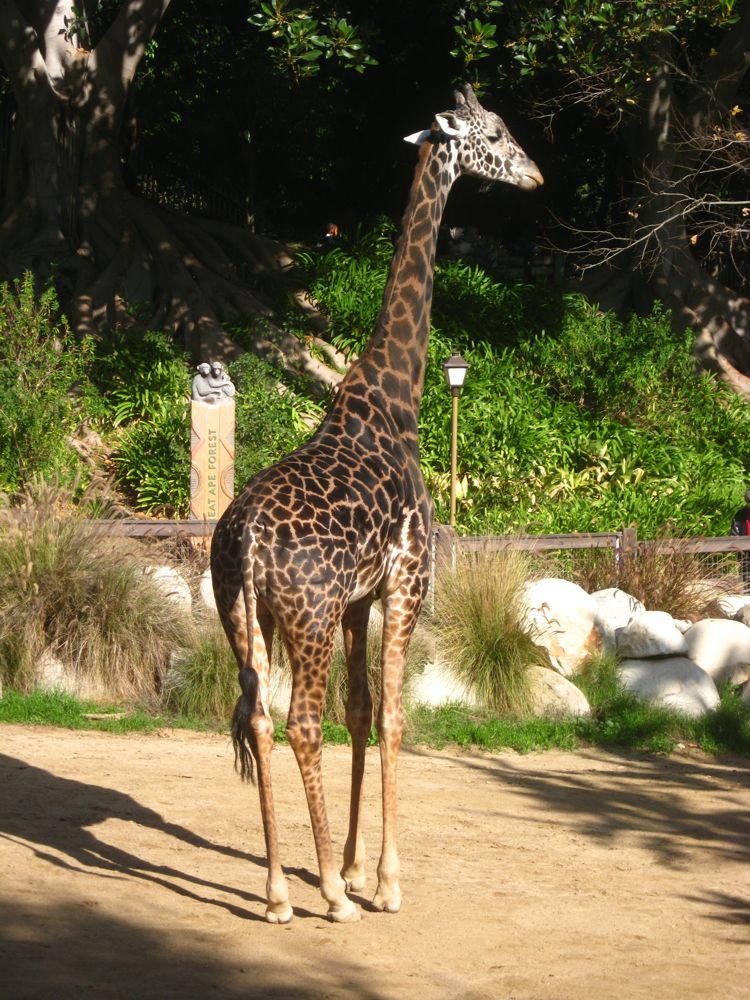
Orangutans Are Funny
Did you know? - Orangutans are the only exclusively Asian living genus of great ape. They are among the most intelligent primates and use a variety of sophisticated tools, also making sleeping nests each night from branches and foliage. They are generally not aggressive and live a mostly solitary life foraging for food. They are the largest living arboreal animals with longer arms than other great apes. Their hair is typically reddish-brown, instead of the brown or black hair typical of other great apes.

They are using old fire hoses for their exercises
Did you know? - Orangutans are the most arboreal of the great apes, spending nearly all of their time in the trees. Every night they fashion sleeping nests from branches and foliage. They are more solitary than other apes; males and females generally come together only to mate. Mothers stay with their babies for six or seven years. There is significant sexual dimorphism: females can grow to around 4 ft 2 in or 127 cm and weigh around 100 lb (45 kg) while flanged adult males can reach 5 ft 9 in or 175 cm in height and weigh over 260 lb (118 kg).

Fuuny guy
Did you know? - Fruit makes up 65–90 percent of the orangutan diet. Fruits with sugary or fatty pulp are favored. Ficus fruits are commonly eaten, because they are easy to harvest and digest. Lowland Dipterocarp forests are preferred by orangutans because of their plentiful fruit. Bornean orangutans consume at least 317 different food items that include young leaves, shoots, bark, insects, honey and bird eggs.

Enjoying life
More To See

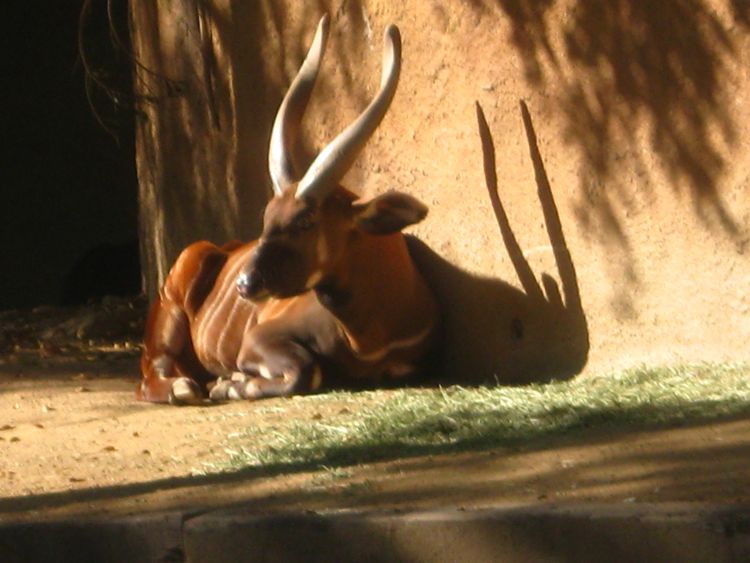

He is difficult to see

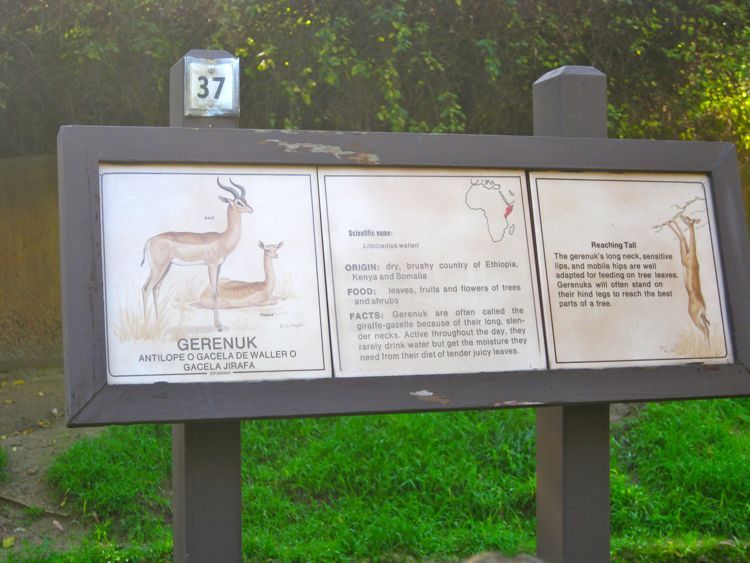
Did you know? - The Gerenuk (Litocranius walleri), also known as the Waller's Gazelle, is a long-necked species of antelope found in dry bushy scrub and steppe in East Africa. The word Gerenuk comes from the Somali language, meaning “giraffe-necked”, and leads to another common name, the Giraffe-necked Antelope. It is the only member of the genus Litocranius.

Very cautious
Did you know? - Gerenuks have a small head for their body, but their eyes and ears are big. Unlike females, males have horns and a more muscular neck. They are brown on their back, and lighter underneath. They have short, black tails. From head to tail, the gerenuk is around 150 cm long. Males are a little taller than females, ranging from 89-105 cm, and the females are 80-100 cm. The male is also heavier than the female, weighing at 45 kg, and females are 30 kg.

Beautiful creatures
Did you know? - Gerenuks eat food from higher places than most other gazelles and antelopes. They do this by standing up on their hind legs, and stretching out their long necks to get food off of tall bushes or small trees. Most of their diet is made up of tender leaves and shoots of prickly bushes and trees, but also includes buds, flowers, fruit, and climbing plants.
Gerenuks do not need to drink, because they get enough water from the plants they eat. Because of this, they can survive in their dry habitat.
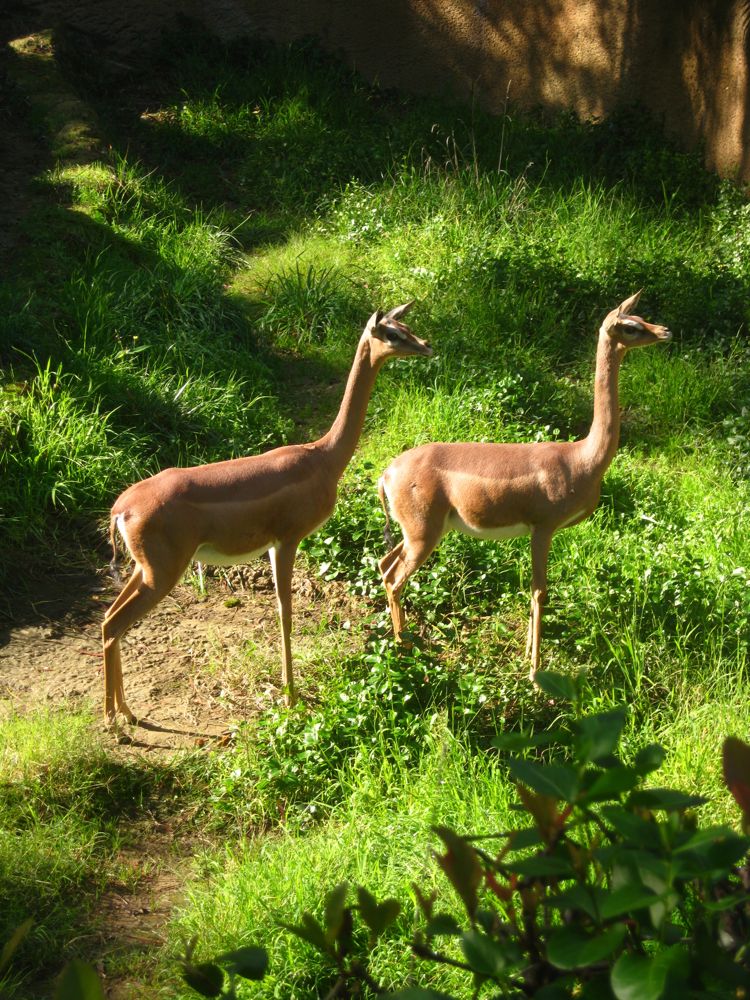
Did you know? - They can mate during any time of the year. Females reach sexual maturity at one year, and males reach sexual maturity at 1.5 years. The gestation period is about seven months. They are born one at a time, weighing about 3 kg at birth. Their life span is about eight years in the wild, but they can live thirteen years or more in captivity.
